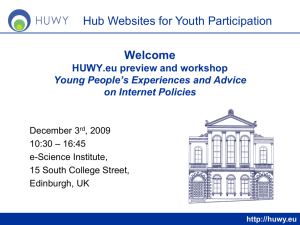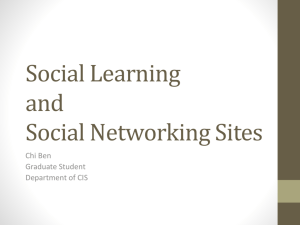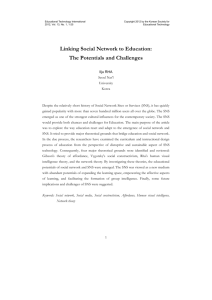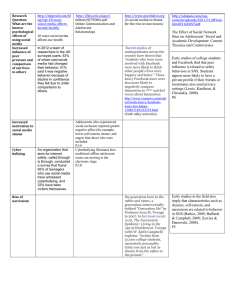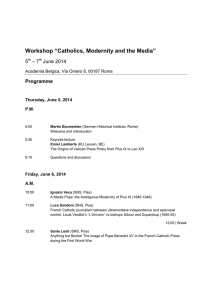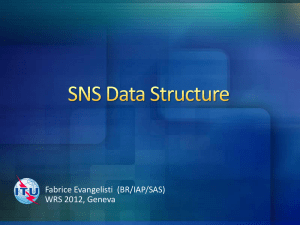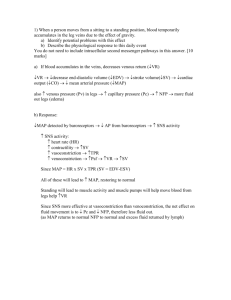This research explores the Social Network Site (SNS) appropriation processes
advertisement
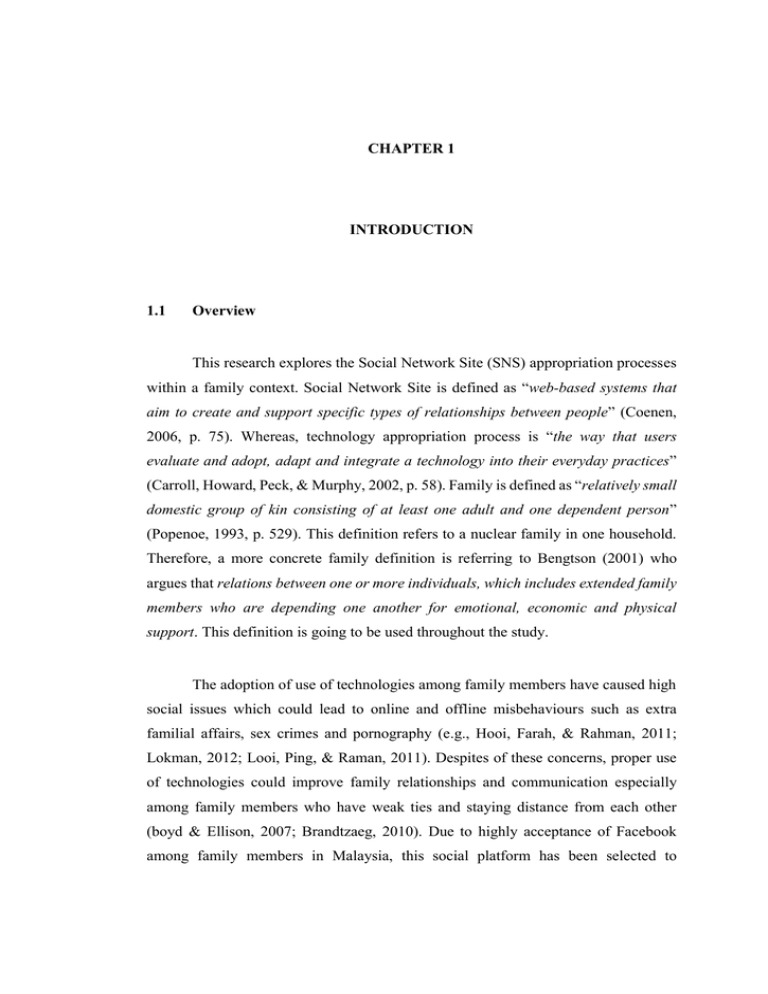
CHAPTER 1 INTRODUCTION 1.1 Overview This research explores the Social Network Site (SNS) appropriation processes within a family context. Social Network Site is defined as “web-based systems that aim to create and support specific types of relationships between people” (Coenen, 2006, p. 75). Whereas, technology appropriation process is “the way that users evaluate and adopt, adapt and integrate a technology into their everyday practices” (Carroll, Howard, Peck, & Murphy, 2002, p. 58). Family is defined as “relatively small domestic group of kin consisting of at least one adult and one dependent person” (Popenoe, 1993, p. 529). This definition refers to a nuclear family in one household. Therefore, a more concrete family definition is referring to Bengtson (2001) who argues that relations between one or more individuals, which includes extended family members who are depending one another for emotional, economic and physical support. This definition is going to be used throughout the study. The adoption of use of technologies among family members have caused high social issues which could lead to online and offline misbehaviours such as extra familial affairs, sex crimes and pornography (e.g., Hooi, Farah, & Rahman, 2011; Lokman, 2012; Looi, Ping, & Raman, 2011). Despites of these concerns, proper use of technologies could improve family relationships and communication especially among family members who have weak ties and staying distance from each other (boyd & Ellison, 2007; Brandtzaeg, 2010). Due to highly acceptance of Facebook among family members in Malaysia, this social platform has been selected to 2 understand its adoption, adaptation and use (Muhamad Sham, 2011; thestar.com, 2010). Previous literatures mentioned that most of the existing research on ICT in family context have focused much on the outcomes from the individual perspective rather than multiple family relationships (Padilla-Walker, Coyne, & Fraser, 2012). However, several researches have shown that family members are often engaging in using the technologies together to stay connected and structuring the family routines (Mesch, 2006). Thus, it will be relevant to explore the SNS appropriation process in family context to understand why and how do family members adopt, adapt and use it. The proposed conceptual framework named Family Appropriation Process of Social Network Site (FAPSNS) is used to explore the SNS appropriation process criteria in different types of family relationships. This chapter gives an overview of the research and it is outlined in several sections. It starts off with the research background (Section 1.2), in which it is summarised in the problem statement (Section 1.3). Based on the problem statement, research questions (Section 1.4) and research objectives (Section 1.5) are then outlined. The chapter then describes the importance of the study in terms of theory, practice and methodology (Section 1.6). Later on, it describes the research scope (Section 1.7) and concludes the structure of the whole thesis (Section 1.8). The overall arrangement for Chapter 1 is illustrated in Figure 1.1. 3 Figure 1.1: Organisation of Chapter 1 1.2 Research Background Families are becoming more dispersed and consequently changing the ways they communicate due to geographical distance, time different and hectic schedules (Little, Sillence, Sellen, & Taylor, 2009). Hence, the introduction of Social Network Site (SNS) which has become an integral part of mainstream family life could change the quality of family relationships in positive ways. In general term, SNS is a free application that enables users to create and share content, or to participate in social networking. Therefore, this online communication could complement or replace inperson interactions among geographical dispersed family in order for them to get connected easily (Brandtzaeg, 2010). It could also improve communication and family activities for those who are staying together within the household (Wen, Kow, & Chen, 2011). Previous family researches have indicated that the usage of communication technologies such as SNS in family settings is able to extend and support the 4 relationships as well as improve the communication and reduce the loneliness syndrome (e.g., Jomhari, Gonzalez, & Kurniawan, 2008; Wen et al., 2011; Williams & Merten, 2011). However, this area of study is still under researched and need further investigations by the researchers (Brown & Venkatesh, 2005; Maier, Laumer, & Eckhardt, 2011). Previous studies show that the quantity and quality of family time could influence on children’s attitudes (Mesch, 2006; Zarinah & Rozumah, 2009). Parents who neglect their children upbringing and education have caused many social issues such as sex, baby dumping and drugs (Mohd. Taib & Noor Baiduri, 2011; Ramasamy, 2012). The negative scenarios even worsen with the easy Internet access by the children without parents or caretakers surveillance (Whitby, 2011) and lack in quality time and communication with their family members (Kulala, 2011). Concerns about using SNS among families in Malaysia have been reported in the newspapers. This includes sex crimes, identity frauds, blackmails and other online crimes which lead to the offline misdemeanours including murder cases (e.g.,Aruna, 2011; Hooi et al., 2011; Looi et al., 2011; Ramasamy, 2012; themalaymailonline.com, 2014; thestar.com, 2013; Yahya & Lai, 2011) which somehow affect the family relationships (Mesch, 2006). However, the negative issues could be minimised when the family members are more aware and knowledgeable on the SNS usage which might bring benefits toward the family communications and relationships. According to Malaysian Communications and Multimedia Commission (MCMC) statistics on Internet use in the household, from 30.39 million of the population, 70.4% have an Internet subscription at home (Azilawati & Mani, 2015). Previously, data have been collected from a random sample of 6144 Internet users in households and 80% of the users are using SNSs (Eng, Dayang Aidah, & Yee, 2011). To date, Facebook is the most popular SNS in Malaysia (onlinesocialmedia.net, 2014; Socialbakers, 2014) and result from the study shows that approximately 100,000 Malaysians are joining Facebook every month (Gibson, 2009; Muhamad Sham, 2011). For vast numbers of people living in modernised societies, SNSs such as Facebook have becoming a core feature of daily life such that their online and offline world have become at least partially integrated. Even though Facebook has a high level of 5 adoption, adaptation and use, but the understanding of the full capacity of the system within family context is still unknown. Previous researchers have studied the motivations of using rich-media forms of SNS among mothers who are living abroad to maintain ties with their geographically separated parents (e.g., Gonzalez, Jomhari, & Kurniawan, 2012; Jomhari, 2007; Jomhari et al., 2008), whereas study on SNS use among families that currently live together or nearby has been disregarded. Also, most of the extant research on SNS focuses on the outcomes of the study on individual and dyad relationships, and ignoring the family perspective (e.g., Ellison, Steinfield, & Lampe, 2006; Gonzales & Hancock, 2011; Jelenchick, Eickhoff, & Moreno, 2012; Joinson, 2008; Urista, Dong, & Day, 2008). Besides, the technical aspect of SNS has seldom been highlighted in previous literatures since most of the times the research objective is merely focusing on individual perspective (e.g., Alarcón-del-Amo, LorenzoRomero, & Del Chiappa, 2013; Barker, 2009). In order to have a look at family level, a wider perspective is needed which includes multiple family relationships and generations to gain better understanding of the complexity of intergenerational family relationships. Also, external criteria in Computer-Mediated Communication (CMC) researches have been widely applied for technology adoption, but not at the later stages (Zhou & Lu, 2011). Since it is important to include the external criteria during the preand post-adoption of a technology, hence it is noteworthy to include this context within the research area. Since the number of SNS has dramatically increased (Kwon & Wen, 2010), it is important to attract and retain users on the survival and development of SNS in different stages of its lifecycle. More than quarter of SNS users discontinue use after the registration (Chang & Zhu, 2011). Therefore it is important to understand beyond the technology regarding the initial adoption which includes the criteria for nonadoption as well. Analysis from previous literatures show that framework or models of technology in family context always emphasising on the initial introduction of the technology and deemphasising the later stages (e.g., Brown & Venkatesh, 2005; Lanigan, 2012). Also, previous Information Systems (IS) models and frameworks such as Diffusion of Innovation (DOI) (Rogers, 1995), Technology Acceptance Model 6 (TAM) (Davis, 1989) and Use and Gratifications model (Katz, Blumer, & Gurevitch, 1974) have focused more on the initial introduction of the technology as compared to the later phases which makes the actual technology capability in improving the family communication and relationships to be indistinguishable. Many previous studies on technology adoption in family context have employed quantitative approach in which questionnaires with selection of answers to find relationships between factors are used strictly. However, reality shows that researches in family context are much more complicated. Therefore, it is important to understand the real situation after SNS adoption in different types of family relationships. This is because different types of family relationships have different intention of technology usage among family members (Bengtson, 2001). Understanding the technology adoption, adaptation and use in the perspectives of family, individual, technical and external criteria is also essential since different perspectives provide unique criteria and are equally important in shaping how a particular family will be affected by technology adoption, adaptation and use (Lanigan, 2012). 1.3 Problem Statement Family relationships across several generations are becoming more diverse in its structures and functions. The usage of SNS could affect the family relationships and communications, not only towards the positive side, but it could also lead to the negative sides as well. However, only a few studies of technology usage in family context have been done on post-adoption. This makes the actual capability of SNS in improving the family communication within different types of family relationships to remain unclear. Hence, the understanding of different types of family relationships could assist in exploring the SNS appropriation process criteria to comprehend the requirement and suitability of this technology in improving the family communications and relationships. 7 1.4 Research Questions Based on the problem statement described in the previous section, the main research question and its sub-questions are identified. The main research question is: Why and how do family members adopt, adapt and use SNS? The main question is decomposed into four research questions: 1. How to categorise the different types of family groups? 2. Why do family members appropriate SNS and how do they appropriate it in different appropriation process level? 3. How to integrate relevant theories or models that can be used to develop a framework to understand the SNS appropriation process in a family context? 4. How to construct the recommendations of SNS appropriation process in a family context? 1.5 Research Objectives Based on the problem statement and research questions described in the previous sections, the main objective and its sub-objectives are identified. The main research objective is: To understand why and how do family members adopt, adapt and use SNS. The understanding of main research objective could be achieved through these four research objectives: 1. To categorise different types of family groups. 2. To explore the criteria of SNS appropriation process and its current level in a family context. 3. To develop a framework of SNS appropriation process in a family context. 4. To construct recommendations of SNS appropriation process in a family context. 8 1.6 Research Significances The proposed integrated framework not only studies the whole cycle of SNS appropriation process, but it also identifies the current level of appropriation process in the perspective of individual, family and SNS. Also, it could categorise the current level of SNS appropriation process for these three perspectives in different types of family relationships. The result from this study could be used to support future research on SNS especially in terms of its appropriation process. The theoretical, practical and methodological contributions of the research are described from Section 1.6.1 to Section 1.6.3. 1.6.1 Theoretical Implications Model of Technology Appropriation (MTA) that is integrated and extended with Socio-Technical Theory and Family Intergenerational Solidarity in developing the FAPSNS framework provides a more comprehensive understanding of the SNS appropriation process in a family context. Moreover, this framework creates a link between the context and process that families go through in adopting and using Facebook into their daily life. Thus, FAPSNS framework allows scholars and practitioners to understand the criteria of SNS appropriation process in technical, family and individual’s perspective within different types of family relationship context. This framework would be valuable in IS as it could capture the appropriation process criteria on how SNS is adopted, adapted and used by family members starting from the initial introduction of the Web-based system up to a certain level of appropriation. Also, the complexity of human-technology interaction in family context could be captured as well by using the FAPSNS framework. It works by understanding the appropriation process criteria in family, individual, SNS and extra-familial perspectives according to the family groups. 9 1.6.2 Methodological Implications The development of a conceptual framework to study the SNS appropriation among family could be used to assist data collection during case studies as well as data analysis of the case studies’ findings. The qualitative research could obtain richer data in the studied phenomenon. Most of the previous researches are focusing more on quantitative approaches in identifying the factors of adoption, adaptation and use. Meanwhile, qualitative approach allows the exploration and understanding of the research context, and how different criteria emerge different times at appropriation levels which are complex to be captured through quantitative approach. Moreover, the framework could also be used in quantitative research. In future, the criteria that have been found in the qualitative research could be used in quantitative method to make the criteria more generalisable. 1.6.3 Practical Implications The development of the proposed framework and the understanding of SNS appropriation process criteria in family context help relevant scholars, agencies and developers to have a better understanding of SNS adoption, adaptation and use in different types of family relationships. Basically, it could lead to the development of instruments and application for family, family therapists and relevant agencies to analyse the SNS appropriation status in particular and other ICT implementation in general. It also allows SNS developers to have a wider conceptualisation of SNS in order to develop more effective SNS for family members in different types of family relationships. The understanding of SNS appropriation process criteria would help to reduce the expectation gaps between the requirements from family and the functions that are provided by SNS designers. Hence in future, this would assist SNS designer to produce better SNS functions and interface in developing a healthy family communication. Further, the proposed framework and its criteria could help family therapists and relevant government agencies to discuss ways of using SNS to communicate or 10 spend time with family members. Given the technology saturation inherent in modern society, it will be important to share with family the need to communicate through the technology with their family members, especially among younger generations in order to stay connected. Additionally, the development of recommendations from the identified criteria could guide family members and relevant organisations such as Malaysian Communications and Multimedia Commission (MCMC), SNSs designer, family therapists, and relevant scholars for reference in developing a healthy family communications and relationships. In future, this framework could be used by scholars to explore the appropriation process for other technologies that could affect the family system. 1.7 Research Scope This research is specifically focuses on one SNS type which is Facebook due to its highest usage as compared to other forms of SNS. (onlinesocialmedia.net, 2014; Socialbakers, 2014). The reasons for choosing Facebook in this research area are further described in Section 2.2.2. The unit analysis for the case study is family and the target family groups are individuals who have a Facebook account or sharing account with their family members, and listed or unlisted their family members as their ‘online friends’. The target family groups also include different levels of Facebook usage which include non-active users, moderate users and active users in order to capture different levels of the SNS appropriation process. 1.8 Structure of the Thesis The thesis is organised into 8 chapters, as shown in Figure 1.2. The chapters and sections presented in this thesis are interrelated to one another. Therefore, the chapters should not be read in isolation and the best approach to understand the research is by briefly revisiting the related chapters or sections. Chapter 1, 2 and 3 are the chapters which introduce the topic of the research, discuss the related literatures and plans on conducting the research. Chapter 4 categorises SNS appropriation process 11 criteria in family, individual and technical perspectives, and its extra-familial criteria through Systematic Literature Review. Meanwhile, Chapter 5 and 6 describe the empirical work conducted in the research. Chapter 7 and 8 explain the overall analysis and conclusion of the research. Chapter 1 introduces the research topic and discusses the issues as well as problems within the subject matter which is the SNS appropriation process in family context. The chapter begins with a research background encompassing the family members’ adoption, adaptation and use of SNS. The chapter proceeds with the problem statement, research questions and research objectives. Then the chapter explains the research scope and research significance based on its contribution to theory, practice and methodology. Finally, the chapter gives the overview of the thesis structure. Chapter 2 reviews relevant research frameworks, models and concepts related to the studied phenomenon. The chapter begins with the definition of SNS, as well as its advantages and disadvantages. Subsequently, it describes reasons of Facebook being choosen as SNS in this research area and also briefly explains the overview of Facebook as well as its features. The chapter then discusses the importance of family, its definition and types of family. Lastly, it describes the previous researches on Computer-Mediated Communication (CMC) usage in family context which includes a unit of analysis that is usually being used in family research, theories that have been applied previously, and guideline that has been created in previous studies. Chapter 3 describes the research design and methodology used in this study. The chapter begins by discussing various research paradigms and approaches used in social science research. The chapter continues with the discussion on the chosen research paradigm which is interpretive paradigm and the qualitative case study was adopted for data collection. The chapter then describes the operational framework in details for each phase and activities involved throughout the study. Chapter 4 describes the development of the proposed conceptual framework named Family Appropriation Process in Family Context (FAPSNS). Later on, Systematic Literature Review is conducted to identify SNS appropriation process 12 criteria in a family context from the previous studies. Using the procedure of Bandara et al. (2011), the researchers employed a four-phase method to extract, analyse, codify and reporting the literatures. NVivo was employed to conduct the content analysis of 284 articles published between the years of 2006 until 2014. As a result, the criteria of the SNS appropriation process were identified and mapped into FAPSNS framework. Chapter 5 describes the preparatory activities conducted prior to the major case studies. It describes the pilot case studies conducted in two family groups with different family’s and individuals’ backgrounds. The pilot case studies provide background knowledge about SNS appropriation as well as to test drive the instruments that have been developed for this study. Chapter 6 reports on the case studies conducted among 11 families with different backgrounds and levels of Facebook usage. Each case study describes the types of relationships for each individual in the family group using the Bengtson’s family intergenerational solidarity. It highlights the observation analysis that is captured during the interview session. Apart from observation analysis, content analysis for the total of ‘posted by’ for each case study is identified in order to understand the pattern of communication between family members. Then, the SNS appropriation process criteria that are captured during interview session are described and the overall findings are illustrated using tables. The FAPSNS framework is used to guide the data collection throughout the case studies. Chapter 7 analyses the findings from all case studies reported in Chapter 6. Findings from the case studies are compared, contrasted and discussed in more detail by using the FAPSNS framework to guide the analysis. Chapter 8 concludes the study and identifies the research contributions. The chapter gives the conclusion by explaining the research outcomes in relation to the achievement of the research objective. The chapter also describes the research contributions to theory, methodology and practice. Lastly, the chapter discusses the recommendations for future research. 13 Figure 1.2: Organisation of the Thesis
